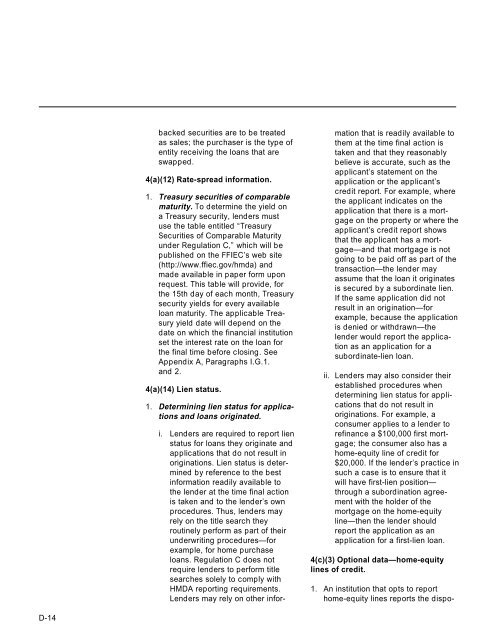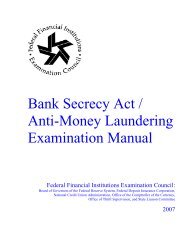A Guide to HMDA Reporting - ffiec
A Guide to HMDA Reporting - ffiec
A Guide to HMDA Reporting - ffiec
Create successful ePaper yourself
Turn your PDF publications into a flip-book with our unique Google optimized e-Paper software.
D-14<br />
backed securities are <strong>to</strong> be treated<br />
as sales; the purchaser is the type of<br />
entity receiving the loans that are<br />
swapped.<br />
4(a)(12) Rate-spread information.<br />
1. Treasury securities of comparable<br />
maturity. To determine the yield on<br />
a Treasury security, lenders must<br />
use the table entitled “Treasury<br />
Securities of Comparable Maturity<br />
under Regulation C,” which will be<br />
published on the FFIEC’s web site<br />
(http://www.<strong>ffiec</strong>.gov/hmda) and<br />
made available in paper form upon<br />
request. This table will provide, for<br />
the 15th day of each month, Treasury<br />
security yields for every available<br />
loan maturity. The applicable Treasury<br />
yield date will depend on the<br />
date on which the financial institution<br />
set the interest rate on the loan for<br />
the final time before closing. See<br />
Appendix A, Paragraphs I.G.1.<br />
and 2.<br />
4(a)(14) Lien status.<br />
1. Determining lien status for applications<br />
and loans originated.<br />
i. Lenders are required <strong>to</strong> report lien<br />
status for loans they originate and<br />
applications that do not result in<br />
originations. Lien status is determined<br />
by reference <strong>to</strong> the best<br />
information readily available <strong>to</strong><br />
the lender at the time final action<br />
is taken and <strong>to</strong> the lender’s own<br />
procedures. Thus, lenders may<br />
rely on the title search they<br />
routinely perform as part of their<br />
underwriting procedures—for<br />
example, for home purchase<br />
loans. Regulation C does not<br />
require lenders <strong>to</strong> perform title<br />
searches solely <strong>to</strong> comply with<br />
<strong>HMDA</strong> reporting requirements.<br />
Lenders may rely on other infor-<br />
mation that is readily available <strong>to</strong><br />
them at the time final action is<br />
taken and that they reasonably<br />
believe is accurate, such as the<br />
applicant’s statement on the<br />
application or the applicant’s<br />
credit report. For example, where<br />
the applicant indicates on the<br />
application that there is a mortgage<br />
on the property or where the<br />
applicant’s credit report shows<br />
that the applicant has a mortgage—and<br />
that mortgage is not<br />
going <strong>to</strong> be paid off as part of the<br />
transaction—the lender may<br />
assume that the loan it originates<br />
is secured by a subordinate lien.<br />
If the same application did not<br />
result in an origination—for<br />
example, because the application<br />
is denied or withdrawn—the<br />
lender would report the application<br />
as an application for a<br />
subordinate-lien loan.<br />
ii. Lenders may also consider their<br />
established procedures when<br />
determining lien status for applications<br />
that do not result in<br />
originations. For example, a<br />
consumer applies <strong>to</strong> a lender <strong>to</strong><br />
refinance a $100,000 first mortgage;<br />
the consumer also has a<br />
home-equity line of credit for<br />
$20,000. If the lender’s practice in<br />
such a case is <strong>to</strong> ensure that it<br />
will have first-lien position—<br />
through a subordination agreement<br />
with the holder of the<br />
mortgage on the home-equity<br />
line—then the lender should<br />
report the application as an<br />
application for a first-lien loan.<br />
4(c)(3) Optional data—home-equity<br />
lines of credit.<br />
1. An institution that opts <strong>to</strong> report<br />
home-equity lines reports the dispo-
















